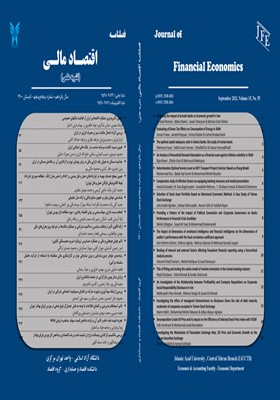برازش مدل بومی بازارگرایی در صنعت بانکداری ایران Title of fitting and testing the native model of market orientation in the Iranian banking industry
محورهای موضوعی : اقتصاد مالی
مجید قلی پور
1
,
یلدا رحمتی
2
*
![]() ,
کامبیز شاهرودی
3
,
کامبیز شاهرودی
3
1 - گروه مدیریت بازرگانی، دانشگاه آزاد اسلامی، واحد رشت، رشت، ایران
2 - گروه مدیریت بازرگانی، واحد رشت، دانشکده مدیریت و حسابداری، دانشگاه آزاد اسلامی، رشت، ایران
3 - گروه مدیریت، دانشکده مدیریت و حسابداری ، دانشگاه آزاد اسلامی اسلامی واحد رشت ،تهران ، ایران
کلید واژه: صنعت بانکداری, G33, روش داده بنیاد, M40, : بازارگرایی, روش معادلات ساختاری. طبقه بندی JEL : G32,
چکیده مقاله :
هدف از پژوهش حاضر، برازش مدل بومی بازارگرایی در صنعت بانکداری ایران میباشد. پژوهش حاضر به صورت آمیخته (کیفی-کمی) بوده و در مرحلة اول، برای ساخت الگو از روش کیفی با رویکرد استروس کوربین و در مرحله دوم برای آزمون الگو از روش معادلات ساختاری استفاده شد. بعد از مطالعه مبانی نظری در خصوص بازارگرایی، طراحی سؤالات مصاحبه، انجام مصاحبه و رسیدن به اشباع نظری، پرسش نامه تدوین شد که 288 گویه و در قالب 59 مفهوم تنظیم شد. جهت بررسی روایی پرسشنامه نهایی در میان 12 خبره صنعت و دانشگاهی توزیع گردید و پس از محاسبه CVR گویهها، این مقدار به 212 گویه در قالب 58 گویه تقلیل یافت. در بخش کیفی جامعة آماری شامل خبرگان برجسته بانکی بوده و در گام دوم که بخش کمی پژوهش بوده است، پرسشنامه پژوهش در میان مدیران میانی، ارشد و کارشناسان 33 بانک کشور توزیع گردید. نتایج نشان داد در بخش کیفی، 54 مفهوم به دست آمده در 6 مقوله شامل راهبردها و اقدامات، شرایط علی، شرایط زمینهای، شرایط مداخلهگر، پیامدها و پدیده محوری جای گرفتند. همچنین با توجه به خروجی نرمافزار در بخش کمی، مقدار ضریب مسیر برای 5 رابطه بین مولفههای مدل مقدار مثبت داشته و این بدان معنی است که روابط مستقیم بوده و تنها رابطه متغیر عوامل مداخلهگر و راهبردها دارای علامت منفی میباشدTitle of fitting and testing the native model of market orientation in the Iranian banking industry Majid GholipourYalda RahmatiKambiz ShahroudiThe purpose of this study is to fit the indigenous model of market orientation in the Iranian banking industry. The present study is mixed (qualitative-quantitative) and in the first stage, the qualitative method with Strauss-Corbin approach was used to construct the model and in the second stage, the structural equation method was used to test the model. After studying the theoretical foundations of market orientation, designing interview questions, conducting interviews and achieving theoretical saturation, a questionnaire was developed that was 288 items in 59 concepts. In order to check the validity of the final questionnaire, it was distributed among 12 industry and academic experts and after calculating the CVR of items, this value was reduced to 212 items in the form of 58 items. In the qualitative part of the statistical population included prominent banking experts and in the second step, which was the quantitative part of the research, a research questionnaire was distributed among middle managers, senior managers and experts of 33 banks in the country. The results showed that in the qualitative section, 54 concepts obtained were placed in 6 categories including strategies and actions, causal conditions, contextual conditions, intervening conditions, consequences and central phenomena. Also, according to the software output in the quantitative part, the path coefficient value for the 5 relationships between the components of the model has a positive value, which means that the relationships are direct and only the variable relationship of interfering factors and strategies has a negative sign.
The purpose of this study is to fit the indigenous model of market orientation in the Iranian banking industry. The present study is mixed (qualitative-quantitative) and in the first stage, the qualitative method with Strauss-Corbin approach was used to construct the model and in the second stage, the structural equation method was used to test the model. After studying the theoretical foundations of market orientation, designing interview questions, conducting interviews and achieving theoretical saturation, a questionnaire was developed that was 288 items in 59 concepts. In order to check the validity of the final questionnaire, it was distributed among 12 industry and academic experts and after calculating the CVR of items, this value was reduced to 212 items in the form of 58 items. In the qualitative part of the statistical population included prominent banking experts and in the second step, which was the quantitative part of the research, a research questionnaire was distributed among middle managers, senior managers and experts of 33 banks in the country. The results showed that in the qualitative section, 54 concepts obtained were placed in 6 categories including strategies and actions, causal conditions, contextual conditions, intervening conditions, consequences and central phenomena. Also, according to the software output in the quantitative part, the path coefficient value for the 5 relationships between the components of the model has a positive value, which means that the relationships are direct and only the variable relationship of interfering factors and strategies has a negative sign.
یادداشتها
_||_

